Want a Good Book to Read Over Winter Break? Here are Some of Our Staff Picks
Explore our reading list, which features a book favored by Barack Obama and authors Colson Whitehead, Shel Silverstein and Octavia Butler.
Now that schools and students are heading into the winter break, it’s the perfect opportunity to tackle any abandoned TBR (to be read) books or pick up a new one before the year ends.
We asked The 74 staff to offer up their latest recommendations, hoping that it might provide those looking for a good read during the cold winter months some engaging options.
Here are 11 books we enjoyed this year:
1. Seven Days in the Art World by Sarah Thornton
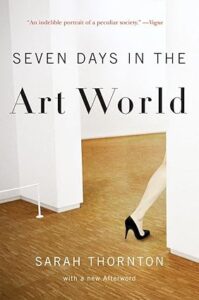
The best decision I ever made was to pursue my love of writing. Second to that is my love of art. I travel around the world with my sketchbook, inspired by architecture, sculptures and paintings from across the globe.
That’s why I was so excited to read Seven Days in the Art World by Sarah Thornton. The opening pages of this incredible book were among the best written in the history of nonfiction books. It reads like a high-level master’s thesis — which sounds like an insult, but actually is not. It was so incredibly informative.
Thornton takes the reader around the world to see where art is made and sold. It was fascinating. I’ve never read a more detailed account of this behind-the-scenes activity than the one Thornton provided. I would love to read this book again. —Jo Napolitano, Senior Reporter
2. The God of the Woods by Liz Moore
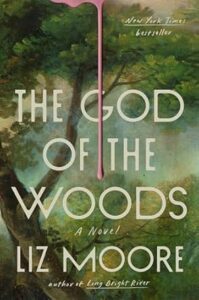
When President Barack Obama releases his annual summer reading list, I pay very close attention — especially to the fiction he chooses. Just days before I found The God of the Woods by Liz Moore on Obama’s list, a friend had touted it as meeting my two book qualifications: it had to be an engaging page turner and it had to grab me on page one — a nod to all my years in New York City tabloid journalism!
The God of the Woods is a combo mystery, thriller and family story set in the summer of 1975 at a camp in upstate New York when Barbara Van Laar — the daughter of the wealthy family that owns the camp — has gone missing. This isn’t the first time a Van Laar child has disappeared — Barbara’s older brother, Bear, also vanished more than a decade before, never to be found.
The search for Barbara uncovers many secrets and sends shockwaves through the wealthy family, the camp, and the blue-collar community that serves them. The characters, particularly Barbara, her parents and camp director T.J., are well-developed and compelling. The plot is full of twists and turns, just like the upstate mountain range where the story is set. I don’t want to say too much other than what my friend said: “Probably a little too good a read if you’ve got a kid at sleepaway camp!” —JoAnne Wasserman, Executive Editor
3. Watergate: A New History by Garrett Graff
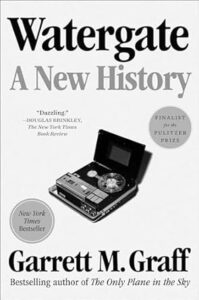
I am a huge fan of journalist and historian Garrett Graff and last summer, I spent a lot of warm evenings on my deck with his Watergate: A New History.
I have vivid memories of watching the 1973 hearings with my parents as a child and of going to see the film version of All the President’s Men a couple of years later. The journalism bug bit me early.
Despite its heft, Graff’s book, published in February 2022, is a page-turner. A half-century after Richard Nixon’s resignation, co-conspirators have served their sentences, sold memoirs and died — freeing an avalanche of information that was unavailable to reporters at the time.
Without the pressure of breaking news deadlines, Graff turns minor players in the conspiracies, cover-ups and investigations into compelling characters. One after another, they come to grips with the depth of the wrongdoing — only to be stunned by new evidence of the president’s involvement.
Especially riveting is the last third of the book, where Congress, cabinet members and Nixon intimates wrestle with questions that are not so removed from today’s headlines: Whether a sitting president can withhold records from the highest courts in the land, how to orchestrate hearings so that they create a narrative understandable to the public and whether it was possible to shield the dignity of the office from the depravity of its occupant. —Beth Hawkins, Senior Writer and National Correspondent
4. The Violin Conspiracy by Brendan Slocumb
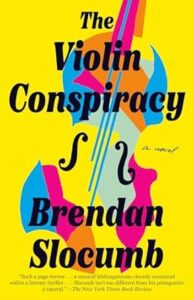
For 2024, I committed to reading only literature by Black authors and it has challenged me to explore new genres. As a first-time mystery reader, I found Brendan Slocumb’s 2022 The Violin Conspiracy to be a captivating and accessible introduction.
The Violin Conspiracy focuses on main character Ray — an honest and passionate Black violinist who discovers a priceless violin connected to his enslaved ancestors. When he chooses to play the instrument during performances, Ray unexpectedly rises to fame as if the violin is a good luck charm. In the book, this is seen as a remarkable feat, reflecting the reality that Black musicians make up just 2.4% of American orchestra members, according to a 2023 League of American Orchestras study.
When Ray’s violin is stolen, his relentless search to recover it consumes his time and takes precedence over preparing for performances. As he navigates both the quest for his instrument and the systemic obstacles Black musicians face in a predominantly white field, Slocumb paints a vivid picture of the personal and professional challenges Ray endures. Though the book contains triggering elements, such as racial slurs and references to slavery, they can serve as crucial elements to understanding the racial issues Slocumb chooses to explore — adding depth to Ray’s struggle with his own identity in the classical music scene.
For those with a personal connection to music — like myself, having played instruments including the violin, for the majority of my life — the novel resonates on a profound level. It felt as though I was part of Ray’s global audience, with the power of his music transcending how I processed the racial tensions at play within the story. Slocumb’s seamless intertwinement of suspense, arts and culture has set a high bar for the rest of my literary journey. —Trinity Alicia, Digital Producer
5. A Light in the Attic by Shel Silverstein
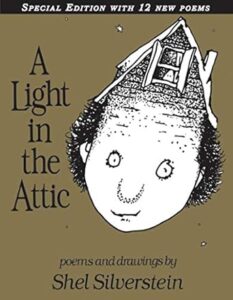
I deeply cherish the fact that the majority of my reading takes place with my children curled up around me, which on its own is pretty sweet. One of their most requested books is Shel Silverstein’s 1981 A Light in the Attic, or what they like to call “funny poem book.”
A Light in the Attic is not only filled with whimsical poetry but is also accompanied by illustrations drawn by Silverstein himself.
A few of my children’s favorite snippets include “mustard ice cream,” “polar bears in Frigidaires,” “Meehoos” and “Exactlywatts.” Some of the poems in the collection are pretty vicious like Who Ordered the Broiled Face? and Skin Stealer, but I think those tend to go over their heads.
My daughter has been extremely interested in one poem called Ladies First! It features a character called Pamela Purse, whom my daughter calls Kamala Harris. Proclaiming “ladies first!” does not always work out well for Pamela, but in some way I think it is inspiring my daughter to understand her own power and how to advocate for herself — except around cannibals.
Their grandpa was a poet, who probably preferred Robert Frost to Silverstein, but I’m sure he would have been proud to witness their fascination with the art form. —Eamonn Fitzmaurice, Art and Technology Director
6. The Nickel Boys by Colson Whitehead
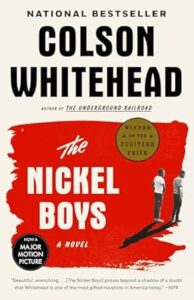
Colson Whitehead was inspired to write The Nickel Boys after reading a news article about archaeology students at the University of South Florida unearthing the bodies of dozens of boys who had been tortured and raped and then buried in unmarked graves on the grounds of The Dozier School for Boys.
His novel revolves around fictional character Elwood Curtis, a Black boy being raised by his grandmother in the Jim Crow-era South. Elwood is a good student and hard worker who gets selected to attend classes at a local college. But when he is unfairly arrested and sentenced to a juvenile reform school called the Nickel Academy in Tallahassee, Florida, his dreams are dashed and his life takes a decidedly dark turn.
At the Nickel Academy, Ellwood is separated from the only family he knows and subjected to strict disciplinary actions and severe beatings. He forges a friendship during his time at the Nickel Academy, an alliance that helps both he and his companion endure the racism and abuse they experience at the hands of the school’s staff.
Whitehead’s novel is gut-wrenching and beautifully written. It shines a light on one of America’s darkest periods and depicts the scars that are left on people who have endured one injustice after another. —Nicole Ridgway, Editor in Chief
7. Beautiful Ruins by Jess Walter
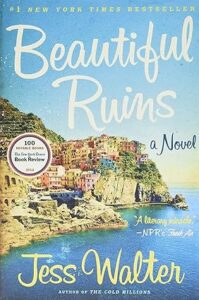
If you’re an Emily in Paris fan, you may have seen the multi-talented Ashley Park singing the song Beautiful Ruins in Rome this season. I can’t help but think it was a sly nod to one of my favorite recent reads, Jess Walter’s 2012 bestseller by the same name that uses the filming of the epic 1960’s flop Cleopatra in Rome as a key plot device.
I am all there for books that satirize Hollywood. This one is a leading example of the insidery, delicious industry send-ups that make Beautiful Ruins such a fun, witty read — including an appearance by the beautiful ruin himself: Richard Burton.
But the heart of the book is the enduring love and friendship between an American starlet and a wistful Italian innkeeper and what happens to them over the course of five decades after their forced parting. And speaking of multi-talented, Walter is also a former Spokane, Washington, newspaper reporter who wrote a definitive account of the 1992 siege at Ruby Ridge. —Kathy Moore, Executive Editor
8. The Bee Sting by Paul Murray
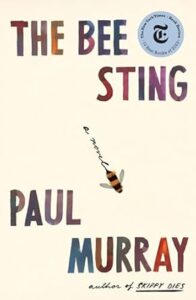
The Bee Sting was by far one of my favorite reads of this year. In Paul Murray’s tragicomic saga, the Barnes family is definitely in trouble.
Dickie’s car business is going under and to cope, he’s spending his days in the woods, building an apocalypse-proof bunker. His wife Imelda is engrossed in selling her jewelry on eBay while barely dodging the attention of a local farmer. Their teenage daughter Cass is binge drinking, and their 12-year-old son PJ is plotting an escape from home.
As the Barnes family grapples with their mounting problems, they face the question of whether they can still rewrite their story and find a happy ending.
Murray is a master in plot with the ability to brilliantly weave together the narratives of seemingly unrelated characters and moments in time. The shifting perspectives brought depth and nuanced character development and the writing was simultaneously crisp and beautiful. This, paired with the surprising and complex ending, has kept the book on my mind since finishing it. —Amanda Geduld, Staff Writer
9. The Earthseed series (Parable of the Sower and Parable of the Talents) by Octavia Butler
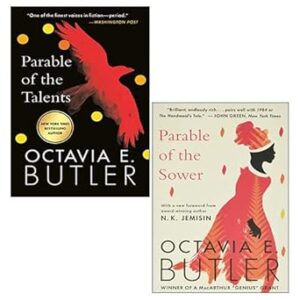
The Earthseed series by one of my favorite authors, Octavia Butler, transcends the typical sci-fi label given by fans and literary experts. Butler’s work is genre blurring, dealing with race, sexism, religion and social commentary.
Published in 1993, the first book Parable of the Sower is set in a post-apocalyptic America where climate change and a kind of civil war feels prescient in today’s politically divided landscape. And guess when this novel takes place? 2025!
The novel follows Lauren Olamina, a young Black woman who can feel the physical and emotional pain of others. After a violent attack on her town she leads survivors and other people they meet along the way to find a safe place to live. Over the course of the story, Olamina forms a religion called Earthseed, which teaches “God is Change” and that humanity must spread out into the Galaxy to seed new worlds.
Parable of the Sower has earned multiple accolades, including being named the 1994 New York Times Notable Book of the Year. The book has since been adapted into an opera and a graphic novel.
Its 1998 sequel Parable of the Talents follows Olimina and daughter Larkin Olamina/Asha Vere. Set in 2032, Olamina establishes an utopian community called Acorn, centered around Earthseed, but things take a dark and brutal turn.
While Butler published a ton of great short stories and novels, this series is one of her best. I can’t recommend it enough. —James Fields, Video Director
10. The Ballad of Black Tom by Victor LaValle
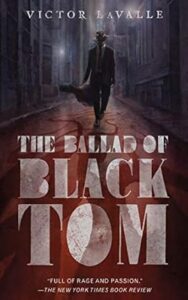
Victor LaValle’s taut, disturbing novella The Ballad of Black Tom begins with a curious dedication: “For H.P. Lovecraft, with all my conflicted feelings.” It suggests the book’s dual purpose: to pay homage to one of the fathers of modern horror while also holding a funhouse mirror up to the legacy of one of the more notorious racist authors in any genre.
LaValle, who is Black, sets his mystery in Jazz Age New York. Charles Thomas Tester, a hustler who walks the streets of Harlem with an empty guitar case, is trying to make ends meet and care for his father, “a man who’d been dying ever since his wife of twenty-one years expired.” The call to deliver a mysterious yellow book to a shadowy woman in Queens ultimately brings him in contact with a conspiracy of wealthy families who are quite literally playing with the nature of reality.
LaValle has a lot of fun turning Lovecraftian tropes on their head. For Lovecraft, New York, with its immigrants, vice and crime, was the epitome of everything wrong with the Modern Age. In setting his story there, viewed through the eyes of a Black man, LaValle lovingly evokes Harlem in the morning as being like “a single drop of blood inside an enormous body that was waking up.”
The book was recommended to me by a friend who knows I’m not a fan of horror. But with the exception of one exceptionally bloody (but necessary) scene, The Ballad of Black Tom plays more with eerie psychological suspense than cheap thrills and gore.
While many other books grapple with Lovecraft’s tortured legacy — Matt Ruff’s Lovecraft Country was turned into an uneven series on HBO — LaValle’s work was justly lauded, winning the 2016 Shirley Jackson award for best novella. It deals with timeless themes of identity and the relationship between fathers and sons. But especially in this post-election season, its meditation on conspiratorial thinking, violence and xenophobia feels frighteningly fresh. —Andrew Brownstein, Executive Editor
11. Monsters: A Fan’s Dilemma by Claire Dederer
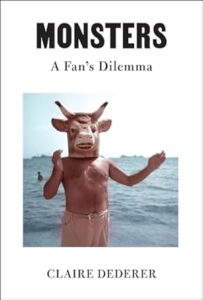
Monsters: A Fan’s Dilemma by Claire Dederer was my favorite read of the year. Yes, it’s wonky and not exactly a beach read, but Dederer, a Seattle-area critic, has written what is probably the most complete exploration ever of the complex relationship between art, its creators and its consumers.
She directly confronts the sometimes uncomfortable truths about our beloved artists (Woody Allen, Miles Davis, Roman Polanski, Pablo Picasso, Wagner … do I need to go on?) who have had messy, sometimes criminally messy, personal lives. While they’re mostly men, she also offers up a critique of women artists (Doris Lessing, Joni Mitchell) who have made problematic personal decisions for their art.
The key question: Can we still love the art but not the artist?
Dederer navigates her own experiences as a fan and a writer while staring down our often contradictory relationship with problematic figures. She offers a helpful analogy, suggesting that we should see our favorite art, music, poetry, writing, etc., as a tapestry. If it’s visibly stained, do we still love it? Perhaps we love it … more?
The book is not just a commentary on specific artists but also an invitation to engage with our own values as consumers of culture. And Dederer’s vulnerability (she is honest about her own shortcomings as a mother in service to both her writing and, well, her drinking) makes the book a compelling read that changed how I think about problematic geniuses. —Greg Toppo, Senior Writer
Get stories like these delivered straight to your inbox. Sign up for The 74 Newsletter
